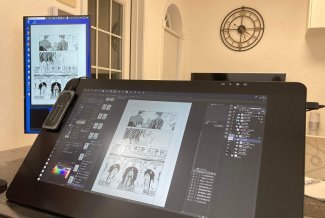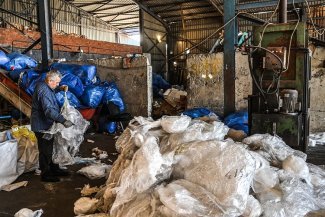A statue of the World War Two special operations heroine Noor Inayat Khan in Gordon Square, London. Khan is the only Muslim woman to be honoured with a public statue in the UK.
One of the most striking images of this summer captured anti-racism protesters toppling a century old-statue of a Confederate soldier in response to a white supremacist rally in the United States.
However, toppling, defacing or vandalising public monuments and statues is not a new way to question which people and events society chooses to venerate and why.
In 2015, students in South Africa smeared excrement on a statue of the British imperialist Cecil Rhodes before the statue was eventually removed. That incident inspired UK students at the University of Oxford to protest for the removal of Rhodes’ statue at one of its colleges in the same year.
Also in Britain, in Bristol earlier this year, the face of a bronze Edward Colston statue – an English slave trader, Member of Parliament and merchant – was painted white by vandals.
Monuments hold public history powerfully. And while some people are challenging accepted ideas about whether statues that celebrate outdated, offensive values should be torn down, others are asking: who else should be remembered?
Bee Rowlatt, writer and chair of a campaign to memorialise early feminist Mary Wollstonecraft (a campaign that is still in need of funding), says the lack of statues of women is the first place to start addressing this question.
“Let’s be honest here, men have written history," Rowlatt told Equal Times. "It’s not that women didn’t do anything, it’s just about who got to write it down, who got to decide what was celebrated and what wasn’t. Women’s achievements have been rendered invisible even though they were doing incredible things but most people have not heard of them.”
Terri Bell-Halliwell, founder of inVISIBLEwomen, a project that campaigns for gender equality in civic statues in the UK, goes further and says it "amounts to the UK’s oldest subliminal ad-campaign for the patriarchy, convincing us all that men are the only ones worth looking up to". She adds that a lack of representation of worthy female role models leaves women and girls “feeling marginalised and unrecognised".
Statistics compiled by the women’s rights campaigner and journalist Caroline Criado-Perez from the database of the Public Monuments and Sculpture Association (PMSA), found there are 925 statues in the UK. However, only 158 of them are stand-alone statues of women – just 15 per cent of the national total.
Even of these 158 statues that exist, Criado-Perez’s research shows that most are of royals (she counted 19 of Queen Victoria), mythical or allegorical figures, the Virgin Mary (who has 14) or generic nudes. She only found 25 statues of specific non-royal women. In February, Times journalist and Conservative member of the House of Lords, Lord Finkelstein, described these figures as "a national embarrassment".
Tackling the disparity with public support
Some of the most well-known women to have statues in the UK include the Crimean War nurse Florence Nightingale, suffragettes Emmeline and Christabel Pankhurst, and the former British prime minister Margaret Thatcher.
But the PMSA database is not comprehensive (some statues erected over the last few years are not even in it) and it is not yet possible to search by the gender of the artist or subject (hence why Criado-Perez waded through records by hand). There is also no breakdown of statues of women of colour or women with disabilities.
Anecdotally, only a handful of statues of women of colour exist, including Mary Seacole, another Crimean War nurse, the indigenous American princess Pocahontas and the pioneering children’s TV presenter Floella Benjamin. One of the few statues of a disabled woman in the UK was of artist Alison Lapper, who featured on the fourth plinth at Trafalgar Square, before it came down in 2007. The statue is owned by the artist and is currently in need of a permanent home.
The charity Art UK recently launched a project to catalogue more than 170,000 sculptures, including the estimated 16,000 works that occupy outdoor public spaces. The database, which will take four years to complete, is said to be a world-first and is supported by £2.8 million of Lottery money. It could go some way towards compiling a more comprehensive list of female statues.
Bell-Halliwell says that the general disparity could also be tackled through public support. "Public opinion is quite powerful in this regard,” she says. “Public votes for suggested women to honour, harness widespread attention and help bring in political backing and funding.”
This was true for Criado-Perez’s online petition for a statue of women’s suffrage campaigner, Millicent Fawcett, which gained more than 85,000 signatures.
Earlier this week, the Mayor of London Sadiq Khan confirmed that Westminster Council would give planning permission for a statue of Fawcett to be erected in Parliament Square in 2018. It will be paid for by money from a £5 million fund earmarked in the Budget for celebrating the centenary of the Representation of the People Act of 1918, which gave some women the right to vote.
It is the first statue of a woman sculpted by a woman to ever be placed in Parliament Square, a space otherwise occupied by 11 men.
Public support also helped writer Shrabani Basu’s campaign for a bust of British World War Two spy Noor Inayat Khan, which sits in Gordon Square in London. The journey to erect the only statue of a Muslim woman in the UK was not an easy one.
Basu, who wrote the biography of Khan’s life says it took two years to get funding, including writing letters “until my fingers were falling off”.
One of the obstacles which was never articulated openly, was the "sense that there are too many statues of Asian people,” says Basu, referring to the statue of the Nobel Prize-winner Rabindranath Tagore also in Gordon Square and the statue of the Indian civil rights leader Mahatma Gandhi in Tavistock Square, both in central London.
"There was a feeling that there were too many Asians making applications. I definitely felt that,” says Basu. “That was hard because on top of being Indian, Noor was a woman and relatively unknown. We had to really fight to get this through."
Overlooked legacies
Other campaigns are still struggling. Rowlatt has been fighting for a statue of Mary Wollstonecraft for more than five years. "It’s a real injustice that her legacy has been overlooked because she was a very key enlightenment thinker, educational pioneer and foremother of feminism, and she called for women’s political representation 100 years before it was granted,” she says.
“Wollstonecraft came from a really excluded background. She was a single mother, she was self-taught and self-made. She wasn’t from a posh family and her legacy was one of challenging the establishment so it’s much harder to get someone like that acknowledged.”
The campaign for a bronze statue of Sylvia Pankhurst began 18 years ago. Currently, a two-dimensional steel artwork in an east London park is the only public monument of her known to exist. Pankhurst was known for her radical left-wing views, unlike her more conservative mother and sister who have statues in Westminster. She was refused a statue near the House of Lords but could have her own monument in Clerkenwell, London in 2018. It will be partly funded by the City of London Corporation and Islington Council, although donations for the campaign are still needed.
And what support does the UK government offer? While it does not have the responsibility for the creation of new statues, the government does offer the UK-wide Memorial Grants Scheme, allowing charities and faith groups to claim a grant that is equivalent to the VAT paid on the eligible costs of erecting, maintaining or repairing public memorials.
Other public bodies are also taking action. Historic England, which looks after England’s historic built environment, is planning a nationwide campaign about who is remembered in monuments and why in 2018, including a major exhibition called Immortalised.
Celia Richardson, director of communications at Historic England, told Equal Times: "The overwhelming majority of those celebrated are white and male – some with uncomfortable links to colonialism and slavery. At the same time, the stories of many people, including women and people from diverse backgrounds, remain untold and uncelebrated.”
She says the campaign is aiming to start “a conversation about public memorialisation, and engage people in thinking about the sort of stories and people they think should be represented on our streets". The campaign will include uncovering and celebrating places of lesbian, gay, bi-sexual, transgender, queer and intersex heritage across England.
A statue of writer Jane Austen was just unveiled in July in the town of Basingstoke in southern England. Several other statues of women are in the pipeline, including one of Emmeline Pankhurst in Manchester, the late comedian Victoria Wood in Bury in Greater Manchester and of the wartime politician Ellen Wilkinson in Middlesbrough, North Yorkshire.
Progress is happening – even if it’s very slow.










